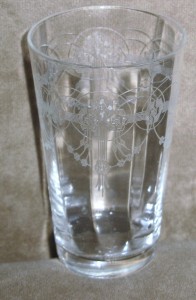Tags
When I first posted this in May I couldn’t identify it. I am pleased to be able to do so now. Yesterday I was in Waterloo at the St. Jacobs Antique Store when I picked up the Encyclopedia of Paden City Glass by Carrie and Jerry Domitz. I didn’t necessarily think I had any Paden City glass but I like to be able to recognize pieces that I might buy, or perhaps have.
Lo and behold I saw this etch as I was leafing through the book. I was surprised to discover that it is a needle etch. I thought it likely to be plate etching. The authors say, “This is probably the last pattern that would have been identified as Paden City.” They also say that this pattern is unlike any other done by Paden City.
They just call this piece a tumbler and not a juice glass. Interestingly I came across this etch, only for the second time, in St. Jacobs at an Antique Market. The pieces were stems – sherberts and wines. I looked at them (can’t recall the price, but I think they were costly) but didn’t buy as I don’t like to collect a lot of pieces in a pattern if I don’t know what it is. Now of course, I’d like to have a second look!
These stems aren’t mentioned in the book.
__________________________________________________________
A few weeks ago my hubby and I went on an antiquing adventure. We stopped into a large, multi-vendor shop in Glen Valley (Halton Hills). I wish I could remember the name!
We’d been there a year or so ago. A self-propelled police car was acquired for the Man Cave. I think I bought something, but again, can’t quite recall what it/they was/were.
I wandered through this shop. It is large and has something for everyone. I picked up a number of pieces including 6 or 8 of these glasses. I don’t know the etch – have never come across it. It has an art deco appearance.
The vendors were at their booth and I asked if they knew the provenance. The lady said that they had belonged to her mother, but didn’t know anything about them other than they were old.
I have a couple other etches in this size and shaped blank. I assume that they are juice glasses, although I suppose they could be used for liqueurs. They have a subtle optic.
I’m guessing that these are early twentieth century, but really….they could have been made yesterday. Hope someone out there takes pity on me and lets me know!

Dear Granny,
I actually have a set in this pattern, and Replacements confirmed they called it « Art nouveau tassel » by Paden City, though no one knows for sure what they were called by the glassmakers themselves.
Should you ever come across glasses in this model, I would be so grateful if you could let me know, as I would like to complete the set.
Very sincerely,
Helene Destrempes
Dieppe, New Brunswick
Hi – you are lucky to have a set. I have had a few pieces in the past, but they have been sold. Interestingly one set was sold to a man who said he was using them to stage a theatrical production.
I have not seen this pattern often, but will definitely keep my eyes open.
On another note, my husband is originally from Campbellton. I am sure we have been through Dieppe on one of our trips down East. Pretty country.
Thanks for sharing.
cheers
d.b.
Dear D. B.,
Thank you for your kind reply!
I acquired the set (around 60 pieces, if I count the plates for the short stem sherbet) from a lady, who had herself bought it from an older lady in Quebec city, who said it had belonged to her mother.
The design is definitely art nouveau, this is why I bought it to start with, though I thought the glass was a bit thick (about 10/11mm).
I just wish I knew when this pattern was made. If the book you have read, says, that it is the last Paden City pattern, then it would have likely been manufactured in the 1930’s or 1940’s, but somehow the pattern would have been out of style by then. I don’t know!
On Etsy, I was able to find 6 more Sherbet glasses, and on Ebay, a decanter, but now, I think I’ve bought up whatever had been there for a while!
I’m really happy to have found your website! I really enjoy reading it!
Have a very Merry Christmas and a Happy New Year!
From the Maritimes! (And a stepstone from Campbellton)
Helene
Hi – Thanks for the information. I always find it interesting. The reference to ‘last’ wasn’t a reference to time, more a referral to this pattern was unusual for Paden City.
The company closed its doors in 1951 which gives you an end period. The pattern is needle etched, which tends to be earlier (but my observation only).
You are lucky to have such a large collection.
Thanks for the comment about my blog. I have been very lax about writing on it as I have quite a few pieces that are not up here. Hopefully you have inspired me to start writing again.
Thanks for sharing and Best wishes for a happy and healthy Christmas season and 2018.
cheers
d.b.